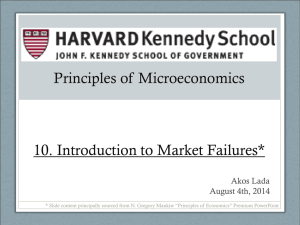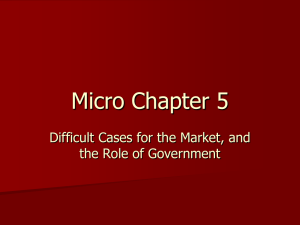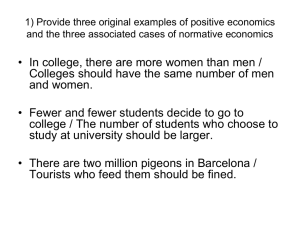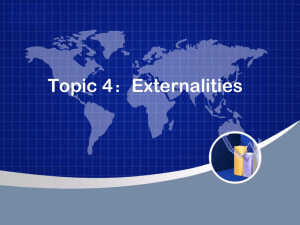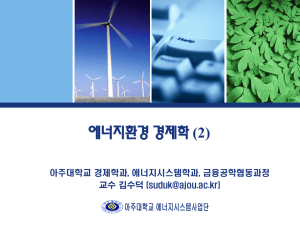Externalities
advertisement
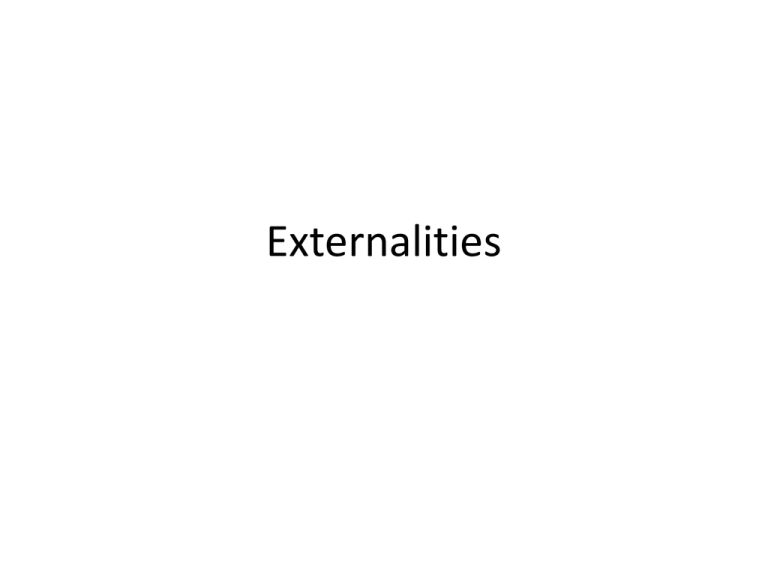
Externalities • The effect of a market action on someone outside of the market • A transaction spillover • A cost or benefit not transmitted through prices affecting someone who did not agree to the action that caused the effect • It is a market failure – Negative Externality • Hurts someone outside of the market – Positive Externality • Helps someone outside of the market • Example of negative externalities – Exhaust from cars – A loud barking dog – An unmowed yard • Examples of positive externalities – Vaccinations – Education – Research in to new technologies • Producers/consumers do not take into account their externalities (ie external) – So government should correct the market failure • Externalities cause inefficient allocation of resources • Remember at efficient point cost = benefit • In other words value to consumers = cost to producers if no externality – That is where supply cross demand • If an externality exists than true benefit (value) or cost is not reflected in the demand/supply curves • Remember – View Supply Curve now as cost curve to society (if no externality) – View Demand Curve as benefit to society (if no externality) – We care about society wide gains (benefits/cost) • Differentiate fairness from efficiency – Doesn’t matter who pays the cost, it is a cost that should matter when finding efficient point – Doesn’t matter who gains, it is a benefit that should be included when finding efficient point Market for Coal Supply (private cost) Market Equilibrium Demand (private value) Q’ • But there exists an externality • Production of coal pollutes local watersheds • So actual Social Cost is greater than cost of production – Remember welfare is about economy wide effects, the total to all, not how its split up • Social Cost – Cost of production plus – Cost to clean water ways • Social cost above the supply curve Market With Negative Externality Social cost (private cost plus external cost) Supply (private cost) Optimum/Efficient Point External Cost Original Market Equilibrium Demand (private value) Q* Q’ • In the presence of a negative externality the optimum point is a quantity lower than the market produces on its own • Governments role is to step in and correct the market failure to maximize welfare • How – Tax producers equivalent to the cost of the externality – This raises the supply curve to the level of private cost plus external cost Tax as Fix To Externality Social cost (private cost plus external cost) Efficient Point = New Eq. With Tax Supply (private cost) Tax = External Cost This is NOT a DWL. The Tax does not make the market Inefficient, it fixes an inefficiency. Demand (private value) Q* Q’ Positive Externality • When there is a positive externality it means the market is not making enough of the good. • The market is inefficient • There is a benefit which is not incorporated in the demand curve • Actual benefit curve to society is above the demand curve • To correct the market failure the government should subsidize the market Market with Positive Externality Optimal/Efficient Point Original Market Equilibrium Private cost = social cost (no negative externality) External Benefit Social Benefit = Private Benefit + external benefit Private Benefit Q’ Q* • Government should place a subsidy on the good equal to the external benefit • This will increase the market to the efficient level • This does not lead to inefficiency like a subsidy on a “good” market does • It fixes an inefficiency due to the market failure that is the externality Market Correction Thru Subsidy Optimal/Efficient Point Private cost = social cost (no negative externality) These units produce are NOT inefficient Original Market Equilibrium Subsidy = External Benefit Social Benefit = Private Benefit + external benefit Private Benefit Q’ Q* • Externalities are Market Failures – Markets with negative externalities produce more than the efficient amount – Markets with positive externalities produce less than the efficient amount – Why? Because the market (supply/demand curves) don’t internalize the external cost/benefit • Taxes/Subsidies correct the failure, they bring us to the efficient point – Taxes shrink the market – Subsidies expand the market Focus on Pollution • How to deal with pollution? • Maybe “command and control” – Government tells companies exactly what to do to limit pollution (like what type of inputs to use, or what type of process) – Not efficient • Maybe use a market based approach (that is provide an incentive) – Taxes – Cap and Trade Pollution Market • Pollution is a byproduct of almost every type of market action • Without it there could be no production of the stuff we like to consume • So we want to think of there being a market for pollution • We want to think of the demand/supply curve in terms of benefits/cost • Again still looking for efficient point Market For Pollution Emissions Value Cost Curve: The cost of the pollution. We have to live with bad side effects. Value of Pollution at efficient level Efficient Point (costs = benefits) Benefit Curve: The value of Polluting. Allows us to produce things Efficient Emission Level Emissions • There is no natural market for pollution • Given no natural market then the price of pollution is zero • Producers will emit pollution till the benefit curve hits the horizontal axis • This is more emissions than is efficient (negative externality so more in market than should be) • Government has to create the market, or create the price to reach efficient level – Problem of having the information to know what the benefit/cost curves look like, because need these to find efficient price or efficient quantity • Can do this two ways • Price the pollution – That is tax pollution at the level of the EQ point • Limit the pollution level – That is Cap the emissions at the level of the EQ pt • Tax or Cap should be set at efficient level – How to find these? Ask and economist. • Either way leads to same outcome • Tax – Government prices pollution and market finds level of emissions • Cap and Trade – Government sets pollution level and market finds price of polluting (Like a market with perfectly inelastic Supply Curve) Equivalence Resulting Price/Quantity the same under both Tax Cap and Trade Market finds price of permit Tax Market decide Quantity Cap • Notice the efficient level of pollution is not zero • We do “want” some pollution – it allows us to make the things we want • But we want an efficient level of pollution – Costs = Benefits • Government must create market because it does not naturally exist • The Tax or Cap-and-Trade does not distort the market, it fixes the market failure

